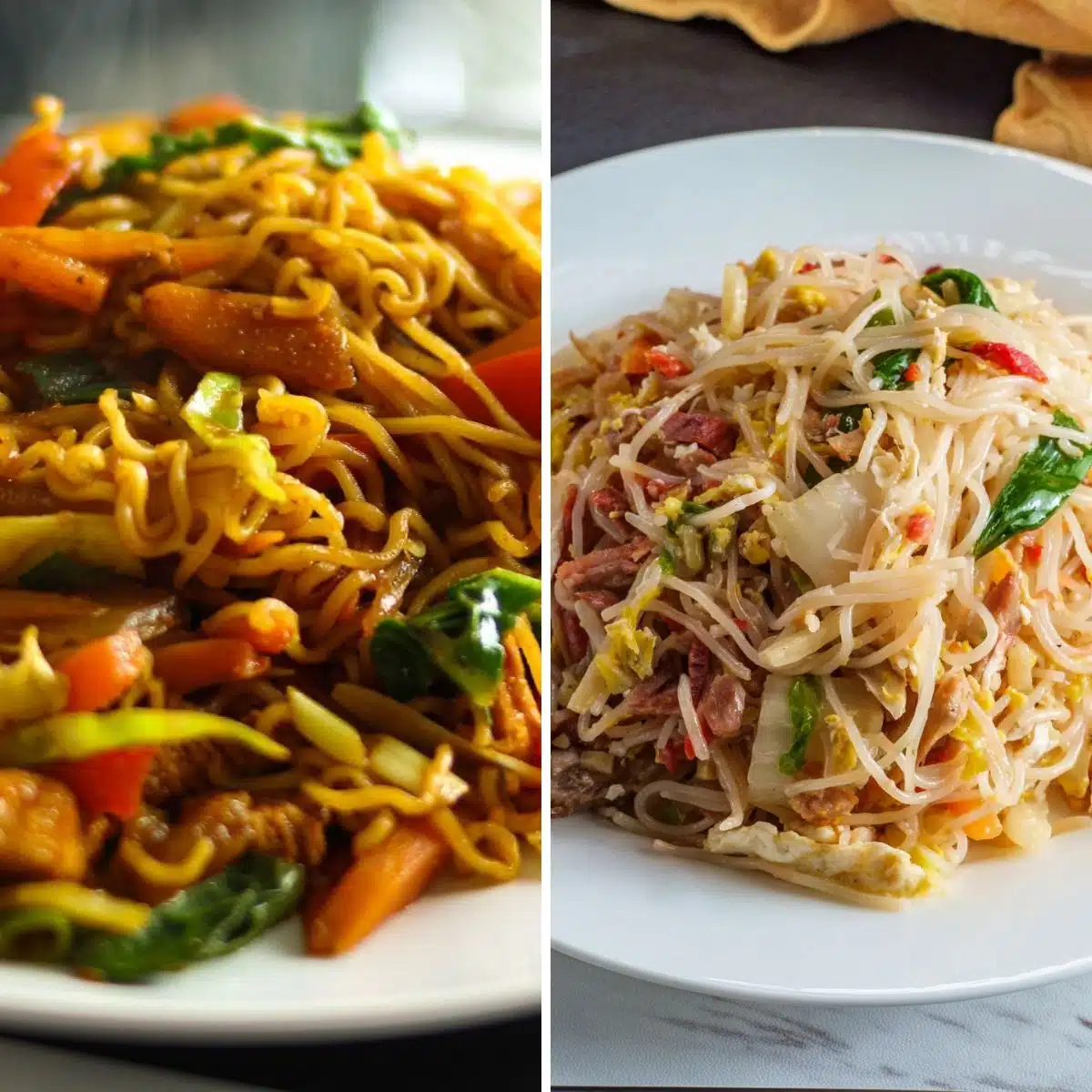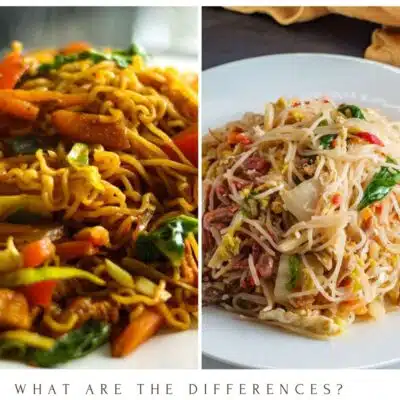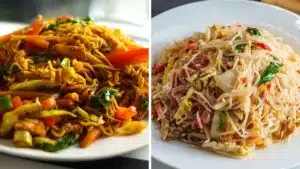Chow Mein vs Mei Fun: A complete guide covering the similarities and differences between two popular Asian noodle dishes! From the ingredients used to how they are prepared, I cover everything there is to know. Keep reading to explore why they both deserve a spot in your lunch or dinner rotation.
If you're in the mood for some Chinese recipes, try my Chinese beef meatballs, sweet and sour pork, kung pao shrimp, or moo shu pork.

Jump to:
Chow Mein and Mei Fun are two flavorful Chinese dishes made with stir-fried noodles. They are often compared to each other as they share common ingredients and are prepared in a similar way.
Though they share a lot of similarities, they do have some distinct differences that set them apart. Just remember, if you see them both on a menu, you can't go wrong because they are both incredibly delicious!
What Is Chow Mein
Chow mein is a very popular Chinese dish. It is a stir-fried recipe containing wheat-based egg noodles. The name itself literally means "stir-fried noodles!"
The ingredients themselves can vary and change depending on what region you are in (and, of course, because of personal preferences). Common veggie options include bean sprouts, onion, celery, carrots, and bell peppers.
You'll also usually see some protein, such as chicken, shrimp, pork, beef, or even tofu. These are typically stir-fried together in a wok, along with a tasty sauce that is made of soy sauce, oyster sauce, and garlic.
Two Types Of Chow Mein
There are different methods of frying the noodles in this dish resulting in two distinctive types of Chow Mein: crispy or soft.
- Crispy (or Hong Kong style) Chow Mein: The noodles are typically fried separately from the other ingredients until they reach a dry and crispy texture. The vegetables and meat are often served on the side (or on top) of the noodles with a thick sauce poured on top.
- Steamed (or soft) Chow Mein: This variety has noodles with a softer texture. They are boiled quickly (which is what makes them soft) before being stir-fried with the other ingredients.
Of course, you can always customize your Chow mein with your favorite ingredients and make it suit your needs. You can prefer soft or crispy noodles. Plus, the variety of chow mein you get can change depending on where it was made.
For example, in American Chinese cuisine, celery and bean sprouts are popular added ingredients, and you'll often see crispy fried noodles served on the side.
What Is Mei Fun
Mei fun (also known as rice vermicelli) features a thin, rice-based noodle that is made up of a mixture of rice flour and water. You'll usually see this noodle variety used in Southern Asian recipes.
The name "Mei Fun" is also used to refer to noodle dishes, whether they are stir-fried or incorporated into spring rolls. Since the noodles are neutral in flavor, it's a popular choice to use as a base as it will absorb the flavors of vegetables, meat, and savory Asian sauces.
Mei fun noodles are naturally gluten-free, which makes them great to prepare for people that have dietary restrictions. They're incredibly versatile, too, so it's common to see them in soups, spring rolls, stir-fried dishes, or even salads.
>>>See All Of My Tasty Recipes Here!<<<
Similarities Between Chow Mein and Mei Fun
Although the type of noodles used in these dishes is the biggest difference that sets them apart, there are a few main similarities they share.
- Noodles. These two delicious originated from China and are centered around noodles.
- Stir-Fried. Chow Mein and Mei Fun are both stir-fried in a wok and can include a variety of similar ingredients like veggies and meat.
- Versatility. Mei Fun and Chow Mein are both incredibly versatile. They can be easily customized to individual tastes.
- Sauces. The sauce in both dishes is typically prepared with ingredients like soy sauce, oyster sauce, or sesame oil.
- Asian cuisine. Both noodles are staples in various types of Asian cuisine. They have also been adapted in multiple ways around the world.
Differences Between Chow Mein and Mei Fun
Chow mein and mei fun are both tasty (and popular) Chinese dishes, but that doesn't make them exactly the same. Here are some important differences.
- Noodle type. The main difference between Chow Mein and Mei Fun are the type of noodles used. Mei fun is made with thin rice noodles, while Chow mein is made of wheat-based egg noodles, which can be soft or crispy.
- Preparation. Mei Fun noodles are typically soaked in hot boiling water until they are soft. Then they are added to the stir fry near the end of the cooking process. Chow mein noodles are stir-fried in the wok with the other ingredients during the entire cooking process.
- Regional variations. Chow Mein has two different regional variations, including "crispy" noodles (aka Hong Kong style) and "soft" noodles.
- Flavor. The noodles in a Chow Mein dish have a distinctive eggy flavor. Mei Fun noodles are more neutral.
- Texture. Chow Mein noodles can have a crispy or soft texture, depending on how you prepare them. Mei Fun noodles are more delicate and generally are on the softer side.
- Serving Style. With some variations of Chow Mein, the stir-fried meat and vegetables are served on top of the noodles. On the other hand, the meat and veggies are fully incorporated with the noodles in Mei Fun.
Do you love a recipe you tried? Please leave a 5-star 🌟rating in the recipe card below and/or a review in the comments section further down the page.
Stay in touch with me through social media @ Pinterest, Facebook, Instagram, or Twitter! Subscribe to the newsletter today (no spam, I promise)! Don't forget to tag me when you try one of my recipes!
📖 Recipe Card
Chow Mein vs Mei Fun: Cantonese Chow Mein (+More Great Information About These Two Dishes!)
Ingredients
- 2 tablespoon soy sauce (reduced sodium recommended)
- 2 tablespoon dark soy sauce
- 2 teaspoon sugar
- 1 teaspoon sesame oil
- 15 oz chow mein noodles
- 2 tablespoon cooking oil
- 8 oz mung bean sprouts (rinsed and drained)
- 3 stalks green onion (chopped)
- 2 bunches baby bok choy (optional, coarsely chopped)
- 2 teaspoon sesame seeds (optional for garnish)
(Note: 2x or 3x only changes the ingredient list)
Instructions
- Make the sauce in a small mixing bowl by whisking together 2 tablespoon soy sauce, 2 tablespoon dark soy sauce, 2 teaspoon sugar, and 1 teaspoon sesame oil. Set aside.
- Boil the 15 oz chow mein noodles as directed on the package (about 10 minutes). Once cooked, drain them and set aside.
- Add 2 tablespoon cooking oil to a large wok or frying pan over medium heat. Once the oil is shimmering hot, add the cooked chow mein noodles and let them fry until golden and crispy on the bottom.
- Flip the noodles over, adding more oil if needed, and fry the opposite side until golden and crispy. You can press down on the noodles gently with a spatula if needed.
- Add 8 oz mung bean sprouts, 3 stalks green onion, and the optional 2 bunches baby bok choy and stir fry for another 30 seconds to 1 minute or until the veggies are cooked to your liking.
- Add your prepared sauce to the pan and toss until all the noodles are evenly coated, then remove from heat. Garnish with 2 teaspoon sesame seeds if desired, and serve right away.
Notes
- Cantonese chow mein calls for regular soy sauce for its salty flavor in addition to dark soy sauce which provides color and a bit of sweetness. The combination of the two gives the sauce its signature balance of flavors!
- You can add any of your favorite stir-fry vegetables to this chow mein. Bell peppers, shredded carrots, zucchini, and mushrooms would all be delicious!
- Give your chow mein a zesty kick by adding some red chili paste or chili oil to the stir-fry sauce.
- To store: Store any leftover Chow Mein in an airtight container in the fridge for up to 3 days.
- To reheat: Reheat your leftovers in a pan over medium heat, stirring frequently until warmed through. You can also reheat individual portions in the microwave.
Nutrition
Originally published July 16, 2023



Comments
No Comments